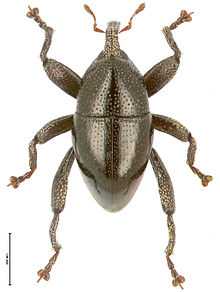Trigonopterus
| Trigonopterus | |
|---|---|
 | |
| Trigonopterus vandekampi from New Guinea | |
 | |
| 100 Trigonopterus species described in 2013 | |
| Scientific classification | |
| Kingdom: | Animalia |
| Phylum: | Arthropoda |
| Class: | Insecta |
| Order: | Coleoptera |
| Superfamily: | Curculionoidea |
| Family: | Curculionidae |
| Genus: | Trigonopterus C.A.A.Fauvel, 1862 |
Trigonopterus is a genus of flightless weevils placed in the Cryptorhynchinae of Curculionidae. It is distributed in the area between Sumatra, Samoa, the Philippines, and New Caledonia. About 90 species had been formally described until March 2013, when a single paper more than doubled this number,[1] agreeing with previous studies[2] and a systematic barcoding study[3] that many more species have yet to be described.
The center of its diversity appears to be New Guinea where 51 or more species can be found in a single locality.[4] Many of them are very similar to each other, but male genital characters and DNA barcoding allow a safe identification.
The genus can be diagnosed among wingless cryptorhynchine weevils by the absence of a metanepisternum and by a synapomorphic structure of the tarsus with minute claws and a deeply incavated articulation of tarsomere 4.
Trigonopterus species inhabit primary tropical forests, both on foliage and edaphic in the litter layer.
Trigonopterus oblongus
The species Trigonopterus oblongus (Pascoe, 1885) is found in Papua.[5] It became notable in July 2011 when examination of the anatomy of the weevil revealed the first instance of a biological screw joint.[6] T. oblongus is just 4 millimetres (0.16 in) long and can fold their legs below their body. The biological screw joint is just 0.5 millimetres (0.020 in) in size.[7][8] This discovery was made by Alexander Riedel of the Karlsruhe State Museum of Natural History and by Thomas van de Kamp of the Karlsruhe Institute of Technology .[7]
Mechanism

The arthropod hip-leg joint consists of two parts - the coxa (or the hip) and the trochanter (or the head of the arthropod leg femur).[9] The coxa, in the case of Trigonopterus oblongus, resembles a nut, and it has a thread running along its inner surface with an angular span of 345°.[6][9] The trochanter resembles the screw.[9] It is rod-shaped with a large external spiral flange, having an angular span of 410°, in excess of a full circle, which functions as a thread.[6] When the leg muscles of a beetle are stretched, the screw turns. Though the screw-thread provide for very large angular rotation, the front legs are capable of rotating by 90°, while their hind legs can rotate by 130°.[10]
Evolution
The screw-and-nut system has now been found to be present in all 15 weevil species examined by the scientists and appears to be a hitherto unknown anatomical feature of weevils.[7][10] It has been estimated that weevils evolved this system about 100 million years ago. It is surmised that the development of this feature provided additional flexibility which permitted weevils to improve their climbing abilities, helped them keep steady when at rest, and to give a stronger leverage for piercing by the snout.[7]
References
| Wikispecies has information related to: Trigonopterus |
| Wikimedia Commons has media related to Trigonopterus. |
- ↑ Riedel, A.; Sagata, K.; Surbakti, S.; Tänzler, R.; Balke, M. (2013). "One hundred and one new species of Trigonopterus weevils from New Guinea". ZooKeys 280: 1. doi:10.3897/zookeys.280.3906.
- ↑ Alexander Riedel (2010). "One of a thousand - a new species of Trigonopterus (Coleoptera, Curculionidae, Cryptorhynchinae) from New Guinea". Zootaxa 2403: 59–68.
- ↑ Riedel, A.; Sagata, K.; Suhardjono, Y. R.; Tänzler, R.; Balke, M. (2013). "Integrative taxonomy on the fast track - towards more sustainability in biodiversity research". Frontiers in Zoology 10 (1): 15. doi:10.1186/1742-9994-10-15. PMID 23537182.
- ↑ Alexander Riedel, Daawia Daawia & Michael Balke (2010). "Deep cox1 divergence and hyperdiversity of Trigonopterus weevils in a New Guinea mountain range (Coleoptera, Curculionidae)". Zoologica Scripta 39 (1): 63–74. doi:10.1111/j.1463-6409.2009.00404.x.
- ↑ Riedel, Alexander. "The True Weevils (Coleoptera: Curculionoidea, Curculionidae) of Papua Indonesia". Taxonomic and faunistic overviews on the insect species living in Papua and West-Papua (Indonesian New Guinea). The Papua Insect Foundation. Retrieved 22 July 2011.
- ↑ 6.0 6.1 6.2 van de Kamp, Thomas; Vagovic, Patrik; Baumbach, Tilo & Riedel, Alexander (1 July 2011). "A Biological Screw in a Beetle's Leg". Science 333 (6038): 52. doi:10.1126/science.1204245. PMID 21719669.
- ↑ 7.0 7.1 7.2 7.3 Karlsruhe Institute of Technology (source) (5 July 2011). /releases/2011/07/110701082802.htm= "Nature uses screws and nuts: Previously unknown musculoskeletal system discovered in weevils". ScienceDaily. Retrieved 25 July 2011.
- ↑ Tenenbaum, David J. (30 Jun 2011). "Meet the biological screw". The Why Files. whyfiles.org. Retrieved 25 July 2011.
- ↑ 9.0 9.1 9.2 Ross, Valerie (30 Jun 2011). "Zooming in on Beetles’ Knees, Biologists Find Tiny Screws and Nuts". Discover magazine. Kalmbach Publishing Co. Retrieved 22 May 2011.
- ↑ 10.0 10.1 Brown, Mark (5 July 2011). "Weevil Has Nuts and Bolts in Its Legs". Wired Science. Condé Nast Digital. Retrieved 25 July 2011.
.jpg)